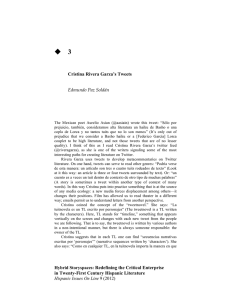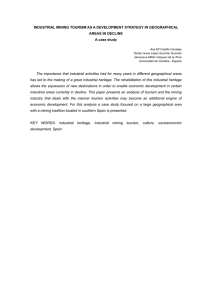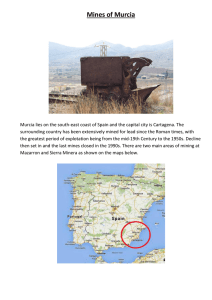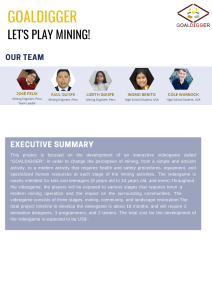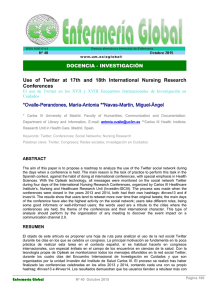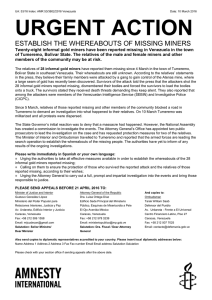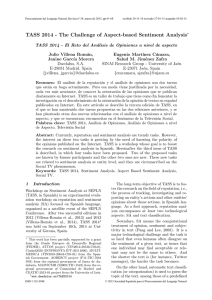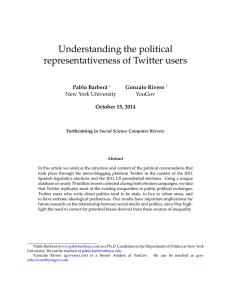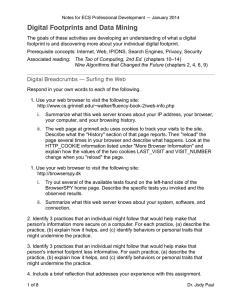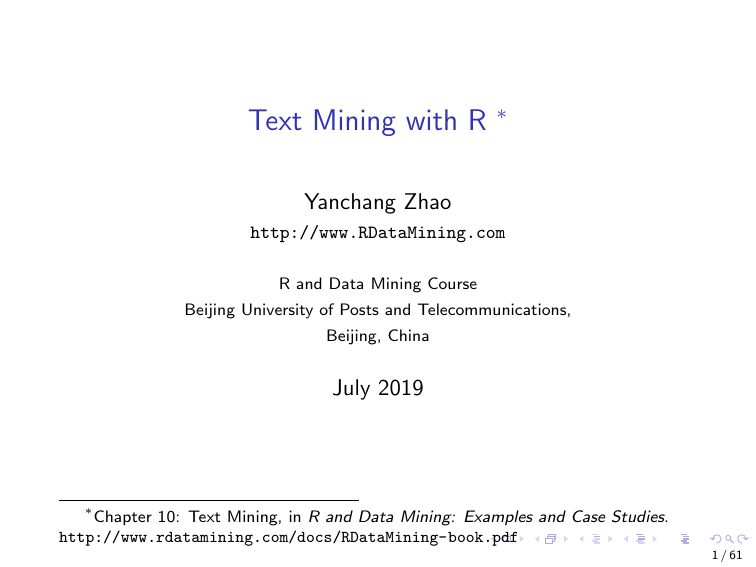
Text Mining with R
∗
Yanchang Zhao
http://www.RDataMining.com
R and Data Mining Course
Beijing University of Posts and Telecommunications,
Beijing, China
July 2019
∗
Chapter 10: Text Mining, in R and Data Mining: Examples and Case Studies.
http://www.rdatamining.com/docs/RDataMining-book.pdf
1 / 61
Contents
Text Mining
Concept
Tasks
Twitter Data Analysis with R
Twitter
Extracting Tweets
Text Cleaning
Frequent Words and Word Cloud
Word Associations
Clustering
Topic Modelling
Sentiment Analysis
Follower Analysis
Retweeting Analysis
R Packages
Wrap Up
Further Readings and Online Resources
2 / 61
Text Data
I Text documents in a natural language
I Unstructured
I Documents in plain text, Word or PDF format
I Emails, online chat logs and phone transcripts
I Online news and forums, blogs, micro-blogs and social media
I ...
3 / 61
Typical Process of Text Mining
1. Transform text into structured data
I Term-Document Matrix (TDM)
I Entities and relations
I ...
2. Apply traditional data mining techniques to the above
structured data
I
I
I
I
Clustering
Classification
Social Network Analysis (SNA)
...
4 / 61
Typical Process of Text Mining (cont.)
5 / 61
Term-Document Matrix (TDM)
I Also known as Document-Term Matrix (DTM)
I A 2D matrix
I Rows: terms or words
I Columns: documents
I Entry mi,j : number of occurrences of term ti in document dj
I Term weighting schemes: Term Frequency, Binary Weight,
TF-IDF, etc.
6 / 61
TF-IDF
I Term Frequency (TF) tf i,j : the number of occurrences of
term ti in document dj
I Inverse Document Frequency (IDF) for term ti is:
idf i = log2
|D|
|{d | ti ∈ d}|
(1)
|D|: the total number of documents
|{d | ti ∈ d}|: the number of documents where term ti appears
I Term Frequency - Inverse Document Frequency (TF-IDF)
tfidf = tf i,j · idf i
(2)
I IDF reduces the weight of terms that occur frequently in
documents and increases the weight of terms that occur rarely.
7 / 61
An Example of TDM
Doc1: I like R.
Doc2: I like Python.
Term Frequency
IDF
TF-IDF
8 / 61
An Example of TDM
Doc1: I like R.
Doc2: I like Python.
Term Frequency
IDF
TF-IDF
Terms that can distinguish
different documents are given
greater weights.
8 / 61
An Example of TDM (cont.)
Doc1: I like R.
Doc2: I like Python.
Term Frequency
IDF
Normalized Term Frequency
Normalized TF-IDF
9 / 61
An Example of Term Weighting in R
## term weighting
library(magrittr)
library(tm) ## package for text mining
a <- c("I like R", "I like Python")
## build corpus
b <- a %>% VectorSource() %>% Corpus()
## build term document matrix
m <- b %>% TermDocumentMatrix(control=list(wordLengths=c(1, Inf)))
m %>% inspect()
## various term weighting schemes
m %>% weightBin() %>% inspect() ## binary weighting
m %>% weightTf() %>% inspect() ## term frequency
m %>% weightTfIdf(normalize=F) %>% inspect() ## TF-IDF
m %>% weightTfIdf(normalize=T) %>% inspect() ## normalized TF-IDF
More options provided in package tm:
I weightSMART
I WeightFunction
10 / 61
Text Mining Tasks
I Text classification
I Text clustering and categorization
I Topic modelling
I Sentiment analysis
I Document summarization
I Entity and relation extraction
I ...
11 / 61
Topic Modelling
I To identify topics in a set of documents
I It groups both documents that use similar words and words
that occur in a similar set of documents.
I Intuition: Documents related to R would contain more words
like R, ggplot2, plyr, stringr, knitr and other R packages, than
Python related keywords like Python, NumPy, SciPy,
Matplotlib, etc.
I A document can be of multiple topics in different proportions.
For instance, a document can be 90% about R and 10%
about Python. ⇒ soft/fuzzy clustering
I Latent Dirichlet Allocation (LDA): the most widely used topic
model
12 / 61
Sentiment Analysis
I Also known as opinion mining
I To determine attitude, polarity or emotions from documents
I Polarity: positive, negative, netural
I Emotions: angry, sad, happy, bored, afraid, etc.
I Method:
1. identify invidual words and phrases and map them to different
emotional scales
2. adjust the sentiment value of a concept based on modifications
surrounding it
13 / 61
Document Summarization
I To create a summary with major points of the orignial
document
I Approaches
I Extraction: select a subset of existing words, phrases or
sentences to build a summary
I Abstraction: use natural language generation techniques to
build a summary that is similar to natural language
14 / 61
Entity and Relationship Extraction
I Named Entity Recognition (NER): identify named entities in
text into pre-defined categories, such as person names,
organizations, locations, date and time, etc.
I Relationship Extraction: identify associations among entities
I Example:
Ben lives at 5 Geroge St, Sydney.
15 / 61
Entity and Relationship Extraction
I Named Entity Recognition (NER): identify named entities in
text into pre-defined categories, such as person names,
organizations, locations, date and time, etc.
I Relationship Extraction: identify associations among entities
I Example:
Ben lives at 5 Geroge St, Sydney.
15 / 61
Entity and Relationship Extraction
I Named Entity Recognition (NER): identify named entities in
text into pre-defined categories, such as person names,
organizations, locations, date and time, etc.
I Relationship Extraction: identify associations among entities
I Example:
Ben lives at 5 Geroge St, Sydney.
Ben
5 Geroge St, Sydney
15 / 61
Contents
Text Mining
Concept
Tasks
Twitter Data Analysis with R
Twitter
Extracting Tweets
Text Cleaning
Frequent Words and Word Cloud
Word Associations
Clustering
Topic Modelling
Sentiment Analysis
Follower Analysis
Retweeting Analysis
R Packages
Wrap Up
Further Readings and Online Resources
16 / 61
Twitter
I An online social networking service that enables users to send
and read short 280-character (used to be 140 before
November 2017) messages called “tweets” (Wikipedia)
I Over 300 million monthly active users (as of 2018)
I Creating over 500 million tweets per day
17 / 61
RDataMining Twitter Account
18 / 61
Process†
1. Extract tweets and followers from the Twitter website with R
and the twitteR package
2. With the tm package, clean text by removing punctuations,
numbers, hyperlinks and stop words, followed by stemming
and stem completion
3. Build a term-document matrix
4. Cluster Tweets with text clustering
5. Analyse topics with the topicmodels package
6. Analyse sentiment with the sentiment140 package
7. Analyse following/followed and retweeting relationships with
the igraph package
†
More details in paper titled Analysing Twitter Data with Text Mining and
Social Network Analysis [Zhao, 2013].
19 / 61
Retrieve Tweets
## Option 1: retrieve tweets from Twitter
library(twitteR)
library(ROAuth)
## Twitter authentication
setup_twitter_oauth(consumer_key, consumer_secret, access_token, access_
## 3200 is the maximum to retrieve
tweets <- "RDataMining" %>% userTimeline(n = 3200)
See details of Twitter Authentication with OAuth in Section 3 of
http://geoffjentry.hexdump.org/twitteR.pdf.
## Option 2: download @RDataMining tweets from RDataMining.com
library(twitteR)
url <- "http://www.rdatamining.com/data/RDataMining-Tweets-20160212.rds"
download.file(url, destfile = "./data/RDataMining-Tweets-20160212.rds")
## load tweets into R
tweets <- readRDS("./data/RDataMining-Tweets-20160212.rds")
20 / 61
(n.tweet <- tweets %>% length())
## [1] 448
# convert tweets to a data frame
tweets.df <- tweets %>% twListToDF()
# tweet #1
tweets.df[1, c("id", "created", "screenName", "replyToSN",
"favoriteCount", "retweetCount", "longitude", "latitude", "text")]
##
id
created screenName replyToSN
## 1 697031245503418368 2016-02-09 12:16:13 RDataMining
<NA>
##
favoriteCount retweetCount longitude latitude
## 1
13
14
NA
NA
##
...
## 1 A Twitter dataset for text mining: @RDataMining Tweets ex...
# print tweet #1 and make text fit for slide width
tweets.df$text[1] %>% strwrap(60) %>% writeLines()
## A Twitter dataset for text mining: @RDataMining Tweets
## extracted on 3 February 2016. Download it at
## https://t.co/lQp94IvfPf
21 / 61
Text Cleaning Functions
I
I
I
I
I
Convert to lower case: tolower
Remove punctuation: removePunctuation
Remove numbers: removeNumbers
Remove URLs
Remove stop words (like ’a’, ’the’, ’in’): removeWords,
stopwords
I Remove extra white space: stripWhitespace
## text cleaning
library(tm)
# function for removing URLs, i.e.,
# "http" followed by any non-space letters
removeURL <- function(x) gsub("http[^[:space:]]*", "", x)
# function for removing anything other than English letters or space
removeNumPunct <- function(x) gsub("[^[:alpha:][:space:]]*", "", x)
# customize stop words
myStopwords <- c(setdiff(stopwords('english'), c("r", "big")),
"use", "see", "used", "via", "amp")
See details of regular expressions by running ?regex in R console.
22 / 61
Text Cleaning
# build a corpus and specify the source to be character vectors
corpus.raw <- tweets.df$text %>% VectorSource() %>% Corpus()
# text cleaning
corpus.cleaned <- corpus.raw %>%
# convert to lower case
tm_map(content_transformer(tolower)) %>%
# remove URLs
tm_map(content_transformer(removeURL)) %>%
# remove numbers and punctuations
tm_map(content_transformer(removeNumPunct)) %>%
# remove stopwords
tm_map(removeWords, myStopwords) %>%
# remove extra whitespace
tm_map(stripWhitespace)
23 / 61
Stemming and Stem Completion
‡
## stem words
corpus.stemmed <- corpus.cleaned %>% tm_map(stemDocument)
## stem completion
stemCompletion2 <- function(x, dictionary) {
x <- unlist(strsplit(as.character(x), " "))
x <- x[x != ""]
x <- stemCompletion(x, dictionary=dictionary)
x <- paste(x, sep="", collapse=" ")
stripWhitespace(x)
}
corpus.completed <- corpus.stemmed %>%
lapply(stemCompletion2, dictionary=corpus.cleaned) %>%
VectorSource() %>% Corpus()
‡
http://stackoverflow.com/questions/25206049/stemcompletion-is-not-working
24 / 61
Before/After Text Cleaning and Stemming
## compare text before/after cleaning
# original text
corpus.raw[[1]]$content %>% strwrap(60) %>% writeLines()
## A Twitter dataset for text mining: @RDataMining Tweets
## extracted on 3 February 2016. Download it at
## https://t.co/lQp94IvfPf
# after basic cleaning
corpus.cleaned[[1]]$content %>% strwrap(60) %>% writeLines()
## twitter dataset text mining rdatamining tweets extracted
## february download
# stemmed text
corpus.stemmed[[1]]$content %>% strwrap(60) %>% writeLines()
## twitter dataset text mine rdatamin tweet extract februari
## download
# after stem completion
corpus.completed[[1]]$content %>% strwrap(60) %>% writeLines()
## twitter dataset text miner rdatamining tweet extract
## download
25 / 61
Issues in Stem Completion: “Miner” vs “Mining”
# count word frequence
wordFreq <- function(corpus, word) {
results <- lapply(corpus,
function(x) grep(as.character(x), pattern=paste0("\\<",word)) )
sum(unlist(results))
}
n.miner <- corpus.cleaned %>% wordFreq("miner")
n.mining <- corpus.cleaned %>% wordFreq("mining")
cat(n.miner, n.mining)
## 9 104
# replace old word with new word
replaceWord <- function(corpus, oldword, newword) {
tm_map(corpus, content_transformer(gsub),
pattern=oldword, replacement=newword)
}
corpus.completed <- corpus.completed %>%
replaceWord("miner", "mining") %>%
replaceWord("universidad", "university") %>%
replaceWord("scienc", "science")
26 / 61
Build Term Document Matrix
## Build Term Document Matrix
tdm <- corpus.completed %>%
TermDocumentMatrix(control = list(wordLengths = c(1, Inf)))
print
## <<TermDocumentMatrix (terms: 1073, documents: 448)>>
## Non-/sparse entries: 3594/477110
## Sparsity
: 99%
## Maximal term length: 23
## Weighting
: term frequency (tf)
%>%
idx <- which(dimnames(tdm)$Terms %in% c("r", "data", "mining"))
tdm[idx, 21:30] %>% as.matrix()
##
Docs
## Terms
21 22 23 24 25 26 27 28 29 30
##
mining 0 0 0 0 1 0 0 0 0 1
##
data
0 1 0 0 1 0 0 0 0 1
##
r
1 1 1 1 0 1 0 1 1 1
27 / 61
Top Frequent Terms
# inspect frequent words
freq.terms <- tdm %>% findFreqTerms(lowfreq = 20) %>% print
## [1] "mining"
"rdatamining" "text"
"analytics"
## [5] "australia"
"data"
"canberra"
"group"
## [9] "university"
"science"
"slide"
"tutorial"
## [13] "big"
"learn"
"package"
"r"
## [17] "network"
"course"
"introduction" "talk"
## [21] "analysing"
"research"
"position"
"example"
term.freq <- tdm %>% as.matrix() %>% rowSums()
term.freq <- term.freq %>% subset(term.freq >= 20)
df <- data.frame(term = names(term.freq), freq = term.freq)
28 / 61
Terms
## plot frequent words
library(ggplot2)
ggplot(df, aes(x=term, y=freq)) + geom_bar(stat="identity") +
xlab("Terms") + ylab("Count") + coord_flip() +
theme(axis.text=element_text(size=7))
university
tutorial
text
talk
slide
science
research
rdatamining
r
position
package
network
mining
learn
introduction
group
example
data
course
canberra
big
australia
analytics
analysing
0
50
100
Count
150
200
29 / 61
Wordcloud
## word cloud
m <- tdm %>% as.matrix
# calculate the frequency of words and sort it by frequency
word.freq <- m %>% rowSums() %>% sort(decreasing = T)
# colors
library(RColorBrewer)
pal <- brewer.pal(9, "BuGn")[-(1:4)]
# plot word cloud
library(wordcloud)
wordcloud(words = names(word.freq), freq = word.freq, min.freq = 3,
random.order = F, colors = pal)
30 / 61
contain
southern
detailed
share
follow
fast
position
example
iapa
data
mining
week
amazon
china
official
analysing package
get
biganalytics
distributed
together notes
state
r
code
build
slide
research
feb tool
software
function
survey
web
cloud
hadoop
youtube australian
performance
website
member
answers support
california improve
australasiannatural san engine
public
industrial
case result
create
thursday
america forecasting
technological source
nov
jan
outlier
check
large
close
database
updated
make sept
open machine
nice
visit call
spark francisco
graph poll available may
quick
business
application provided singapore plot
link
card pls lecture cluster
pdffree australia august knowledge looking
google
dataset lab
track
informal cran
recent
will network workshop
modelinggroup
center
mexico reference
project
sna us top
university video pmmap oct
extended tricks submissiontutorial
various
system
cfp social
search
user
th
tweet
goausdm nd
extract guidance
advanced
v
time detection
find
please june
dr
postdoctoral risk paper
list
developed stanford course
add
useful start
download
forest acm join
event
tuesday
short vacancies science
scientist analyst dynamic
learn
technique
healthcare edited
statistical fit
text book
comment canada
predicting
world
handling twitter
easier
classification dmapps
retrieval thanks
can
prof
present
vs now talk file
decision access april
management
postdoc
interacting rstudiojob online
massive
kdd rule
newlittle
excel
published chapter conference
canberra introduction due fellow
high
snowfall
webinar
step
computational
language rdatamining
friday
skills random
aug give page mapreduce series program document
load mid
seminar associate sydney process
tree deadline
intern
seattle
participation
kdnuggets
sas
area linkedin
visualisations graphical credit
algorithm sigkdd runmelbourne parallel ieee coursera facebook
apache
sunday
senior keynote
sentiment march
iselect version ranked todayexperience titled format initial
neoj
media
spatial
regression
topic
mode
studies task
simple wwwrdataminingcom summit
competition
datacamp
31 / 61
Associations
# which words are associated with 'r'?
tdm %>% findAssocs("r", 0.2)
## $r
##
code example
series
user markdown
##
0.27
0.21
0.21
0.20
0.20
# which words are associated with 'data'?
tdm %>% findAssocs("data", 0.2)
## $data
##
mining
big analytics
science
##
0.48
0.44
0.31
0.29
poll
0.24
32 / 61
Network of Terms
## network of terms
library(graph)
library(Rgraphviz)
plot(tdm, term = freq.terms, corThreshold = 0.1, weighting = T)
big
science
data
talk
canberra
analytics
example
course
r
learn
analysing
text
network
mining
tutorial
slide
rdatamining
group
package
position
research
australia
university
introduction
33 / 61
Hierarchical Clustering of Terms
## clustering of terms remove sparse terms
m2 <- tdm %>% removeSparseTerms(sparse = 0.95) %>% as.matrix()
# calculate distance matrix
dist.matrix <- m2 %>% scale() %>% dist()
# hierarchical clustering
fit <- dist.matrix %>% hclust(method = "ward")
34 / 61
plot(fit)
fit %>% rect.hclust(k = 6) # cut tree into 6 clusters
groups <- fit %>% cutree(k = 6)
data
mining
network
tutorial
analysing
example
package
position
university
research
canberra
analytics
big
australia
slide
30
10
Height
r
50
70
Cluster Dendrogram
.
hclust (*, "ward.D")
35 / 61
## k-means clustering of documents
m3 <- m2 %>% t() # transpose the matrix to cluster documents (tweets)
set.seed(122) # set a fixed random seed to make the result reproducible
k <- 6 # number of clusters
kmeansResult <- kmeans(m3, k)
round(kmeansResult$centers, digits = 3) # cluster centers
##
mining analytics australia data canberra university slide
## 1 0.435
0.000
0.000 0.217
0.000
0.000 0.087
## 2 1.128
0.154
0.000 1.333
0.026
0.051 0.179
## 3 0.055
0.018
0.009 0.164
0.027
0.009 0.227
## 4 0.083
0.014
0.056 0.000
0.035
0.097 0.090
## 5 0.412
0.206
0.098 1.196
0.137
0.039 0.078
## 6 0.167
0.133
0.133 0.567
0.033
0.233 0.000
##
tutorial
big package
r network analysing research
## 1
0.043 0.000
0.043 1.130
0.087
0.174
0.000
## 2
0.026 0.077
0.282 1.103
0.000
0.051
0.000
## 3
0.064 0.018
0.109 1.127
0.045
0.109
0.000
## 4
0.056 0.007
0.090 0.000
0.090
0.111
0.000
## 5
0.059 0.333
0.010 0.020
0.020
0.059
0.020
## 6
0.000 0.167
0.033 0.000
0.067
0.100
1.233
##
position example
## 1
0.000
1.043
## 2
0.000
0.026
36 / 61
## 3
0.000
0.000
for (i in 1:k) {
cat(paste("cluster ", i, ": ", sep = ""))
s <- sort(kmeansResult$centers[i, ], decreasing = T)
cat(names(s)[1:5], "\n")
# print the tweets of every cluster
# print(tweets[which(kmeansResult£cluster==i)])
}
## cluster 1: r example mining data analysing
## cluster 2: data mining r package slide
## cluster 3: r slide data package analysing
## cluster 4: analysing university slide package network
## cluster 5: data mining big analytics canberra
## cluster 6: research data position university mining
37 / 61
Topic Modelling
dtm <- tdm %>% as.DocumentTermMatrix()
library(topicmodels)
lda <- LDA(dtm, k = 8) # find 8 topics
term <- terms(lda, 7) # first 7 terms of every topic
term <- apply(term, MARGIN = 2, paste, collapse = ", ") %>% print
##
...
##
"data, big, mining, r, research, group,...
##
...
##
"analysing, network, r, canberra, data, social,...
##
...
##
"r, talk, slide, series, learn, rdatamini...
##
...
##
"r, data, course, introduction, free, online...
##
...
##
"data, mining, r, application, book, dataset, a...
##
...
##
"r, package, example, useful, program, sli...
##
...
## "data, university, analytics, mining, position, research, s...
##
...
##
"australia, data, ausdm, submission, workshop, mining...
38 / 61
Topic Modelling
rdm.topics <- topics(lda) # 1st topic identified for every document (twe
rdm.topics <- data.frame(date=as.IDate(tweets.df$created),
topic=rdm.topics)
ggplot(rdm.topics, aes(date, fill = term[topic])) +
geom_density(position = "stack")
0.006
0.004
term[topic]
analysing, network, r, canberra, data, social, present
australia, data, ausdm, submission, workshop, mining, august
density
data, big, mining, r, research, group, science
data, mining, r, application, book, dataset, associate
data, university, analytics, mining, position, research, scientist
r, data, course, introduction, free, online, mining
r, package, example, useful, program, slide, code
0.002
r, talk, slide, series, learn, rdatamining, time
0.000
2012
2013
2014
2015
2016
date
Another way to plot steam graph:
http://menugget.blogspot.com.au/2013/12/data-mountains-and-streams-stacked-area.html
39 / 61
Sentiment Analysis
## sentiment analysis install package sentiment140
require(devtools)
install_github("sentiment140", "okugami79")
# sentiment analysis
library(sentiment)
sentiments <- sentiment(tweets.df$text)
table(sentiments$polarity)
# sentiment plot
sentiments$score <- 0
sentiments$score[sentiments$polarity == "positive"] <- 1
sentiments$score[sentiments$polarity == "negative"] <- -1
sentiments$date <- as.IDate(tweets.df$created)
result <- aggregate(score ~ date, data = sentiments, sum)
40 / 61
Retrieve User Info and Followers
## follower analysis
user <- getUser("RDataMining")
user$toDataFrame()
friends <- user$getFriends() # who this user follows
followers <- user$getFollowers() # this user's followers
followers2 <- followers[[1]]$getFollowers() # a follower's followers
##
##
##
##
##
##
##
##
##
##
##
##
##
##
description
statusesCount
followersCount
favoritesCount
friendsCount
url
name
created
protected
verified
screenName
location
lang
[,1]
...
"R and Data Mining. Group on LinkedIn: ht...
"583"
...
"2376"
...
"6"
...
"72"
...
"http://t.co/LwL50uRmPd"
...
"Yanchang Zhao"
...
"2011-04-04 09:15:43"
...
"FALSE"
...
"FALSE"
...
"RDataMining"
...
"Australia"
...
"en"
...
41 / 61
Follower Map§
@RDataMining Followers (#: 2376)
●
●
●
●●
●
●
●
●
●●
●
●
●
●●
●●
●
● ●
●
●
● ●
●
●
●●
●
●
●
●
●
●
●●
●
● ●● ●
●●
●
●●
●
●
●
●
● ●
●●● ●
●
●
●
●●
●
●●
●
●
●
●
●
●
●
●●
●
●
●
●● ●
●
●
●
●●
●
●●
●
●
●●●
● ●●●●● ●
●●
●● ●●
●
●
● ●
●●● ●
●
●
●
●
●
●
● ●
●
●●
●
●
●
●
●
●
●
●
● ●
●
●
●
●
●
●● ●
●
●
●● ●
●
●
● ●● ● ● ● ●
●
●
●
●
●●
●
●● ●
●
●
●
●
●●
●
●
●
● ●●
●
●
●
● ●
●
●
●
●
●●
●
●
●
●
●
●
●
●
● ● ●
●
●
●
● ●
●
●
●
●
●
●●●●●
●
●
●●
●● ●
●●
●●
●
●●
●●
●
●
●
●
●
●
●
●●
●●
●
●●
●
● ● ●●
●
●●
●
●
●
●● ●●●●●
●
●
●
●
●●
●●
●
●●
●●
●
●
●
●
●●
●●
●
●
●
●
●●
●
●
●
●
●
●
●
●
●
●
●
●
●
●
●
●
●
●
●
●
●
●
●
●●
●
●
●
●
●
●
●
●
●●
●
●
●●● ●
●
●
●
● ●●
●●●●
●
●
●●●●
●
● ● ● ●●●
●
●●●
●● ●
●
●●
●
● ●
● ●
●
●
●●
● ●
●
●
●
●
●
●●●●● ●
● ● ●●
●
●
● ●
●●● ● ●
●
●
●
●
●
●
●
●●●
●
●
●
●
●●
●●
●●●
●
●
●●
●●
●
●●
●
●
●
●
●
●●
●
●
●
●
●
●
●
●
●
●● ●
●
●●
●
●
●
●
●
●
●
●●
●
●
●
●●●
●
●
●
●
●
●
●
●
●● ●
●
●●
●
●●
●
●
●
●●
●
●
●●●
●
●
●●● ●●●
● ●●
●●
●●●●
●
●
●
●
●
●
● ●
●
● ●
●
●
●●
●
●
●
●
●
●
●●
●
●
●
●
●
●
●
●
●
●
●
●
●●
●
●●
●
●
●●
●
●●
●
●
● ●
●
●
●
●
●
●
●●
●
●
●
●
●
●
●
● ●●
●
●
●●
●
●●
●
●
● ●
●●
●
●
●
●●●
● ●
●●
●●●
●
●
●
●●
●
●
●
●
●
● ●
●●
●●
●
●
●
●
●●
●
●●
●
●
●
●
●
●
●
●●
●
● ●
●
●
●
●
●
●
● ●
●
●
●●●●●
●
●●
●● ●
●
● ●
●●
●
●
●
●●
●●
●●
● ●
● ●●
●
●
●
●●
●●
●
●●
●●
●
●
●
●
● ●●
●●
● ●● ●
●
●●
●●●
●
●
●
●
● ●
●
●
●
●
●
●
●
●
●
●
● ●
●
●●●
●
●
●
●
●●
●
●
●
●●
●
●
●
●
●●
●
●
●
●
●
●
●
●
●●●
●
●
●
● ●● ●
● ●
●●●
●
●
●
●
●
●●●
●
●●
●
●
●
§
Based on Jeff Leek’s twitterMap function at
http://biostat.jhsph.edu/~jleek/code/twitterMap.R
42 / 61
Active Influential Followers
5.0
M Kautzar Ichramsyah
Prof. Diego Kuonen
● Christopher D. Long
● .................................
●
● Murari Bhartia
#AI PR Girl
●
●
Prithwis Mukerjee
2.0
●
●
● Daniel D. Gutierrez
pavel jašek
●
Zac S.
● David Smith
Mitch Sanders
●
DataCamp
●
●
Marcel Molina
● Data Science London
Derecho Internet
●
Rahul Kapil
Statistics Blog
● Yichuan Wang● Learn R
●
0.5
1.0
Robert Penner
● Roby
● Ryan Rosario
Michal
Illich
Machlis
●●Sharon
StatsBlogs
●
●
biao
● Rob J Hyndman
● Data Mining
● Antonio Piccolboni
0.2
#Tweets per day
10.0 20.0
●
●
●
●
RDataMining
Duccio Schiavon
LearnDataAnalysis
●
5
10
20
50
100
#followers / #friends
43 / 61
Top Retweeted Tweets
## retweet analysis
## select top retweeted tweets
table(tweets.df$retweetCount)
selected <- which(tweets.df$retweetCount >= 9)
## plot them
dates <- strptime(tweets.df$created, format="%Y-%m-%d")
plot(x=dates, y=tweets.df$retweetCount, type="l", col="grey",
xlab="Date", ylab="Times retweeted")
colors <- rainbow(10)[1:length(selected)]
points(dates[selected], tweets.df$retweetCount[selected],
pch=19, col=colors)
text(dates[selected], tweets.df$retweetCount[selected],
tweets.df$text[selected], col=colors, cex=.9)
44 / 61
Top Retweeted Tweets
●
15
Handling and Processing Strings in R −− an ebook in PDF format, 105 pages. http://t.co/UXnetU7k87
10
●
Free online course on Computing for Data Analysis (with R), to start on 24 Sept 2012 https://t.co/Y617n30y Slides in 8 PDF files on Getting Data from the Web with R http://t.co/epT4Jv07WD
●
Lecture videos of natural language processing course at Stanford University: 18 videos, with each of over 1 hr length http://t.co/VKKdA9Tykm
●●
●
5
The R Reference Card for Data Mining now provides links to packages on CRAN. Packages for MapReduce and Hadoop added. http://t.co/RrFypol8kw
0
Times retweeted
A Twitter dataset for text mining: @RDataMining Tweets extracted on 3 February 2016. Download it at https://t.co/lQp94IvfPf
2012
2013
2014
2015
2016
Date
45 / 61
Tracking Message Propagation
tweets[[1]]
retweeters(tweets[[1]]$id)
retweets(tweets[[1]]$id)
## [1] "RDataMining: A Twitter dataset for text mining: @RData...
## [1]
## [5]
## [9]
## [13]
##
##
##
##
##
##
##
##
"197489286"
"244077734"
"11686382"
"6146692"
"316875164" "229796464" "3316009302"
"16900353"
"2404767650" "222061895"
"190569306" "49413866"
"187048879"
"2591996912"
[[1]]
[1] "bobaiKato: RT @RDataMining: A Twitter dataset for text...
[[2]]
[1] "VipulMathur: RT @RDataMining: A Twitter dataset for te...
[[3]]
[1] "tau_phoenix: RT @RDataMining: A Twitter dataset for te...
The tweet potentially reached around 120,000 users.
46 / 61
47 / 61
Contents
Text Mining
Concept
Tasks
Twitter Data Analysis with R
Twitter
Extracting Tweets
Text Cleaning
Frequent Words and Word Cloud
Word Associations
Clustering
Topic Modelling
Sentiment Analysis
Follower Analysis
Retweeting Analysis
R Packages
Wrap Up
Further Readings and Online Resources
48 / 61
R Packages
I Twitter data extraction: twitteR
I Text cleaning and mining: tm
I Word cloud: wordcloud
I Topic modelling: topicmodels, lda
I Sentiment analysis: sentiment140
I Social network analysis: igraph, sna
I Visualisation: wordcloud, Rgraphviz, ggplot2
49 / 61
Twitter Data Extraction – Package twitteR
¶
I userTimeline, homeTimeline, mentions,
retweetsOfMe: retrive various timelines
I getUser, lookupUsers: get information of Twitter user(s)
I getFollowers, getFollowerIDs: retrieve followers (or
their IDs)
I getFriends, getFriendIDs: return a list of Twitter users
(or user IDs) that a user follows
I retweets, retweeters: return retweets or users who
retweeted a tweet
I searchTwitter: issue a search of Twitter
I getCurRateLimitInfo: retrieve current rate limit
information
I twListToDF: convert into data.frame
¶
https://cran.r-project.org/package=twitteR
50 / 61
Text Mining – Package tm
k
I removeNumbers, removePunctuation, removeWords,
removeSparseTerms, stripWhitespace: remove numbers,
punctuations, words or extra whitespaces
I removeSparseTerms: remove sparse terms from a
term-document matrix
I stopwords: various kinds of stopwords
I stemDocument, stemCompletion: stem words and
complete stems
I TermDocumentMatrix, DocumentTermMatrix: build a
term-document matrix or a document-term matrix
I termFreq: generate a term frequency vector
I findFreqTerms, findAssocs: find frequent terms or
associations of terms
I weightBin, weightTf, weightTfIdf, weightSMART,
WeightFunction: various ways to weight a term-document
matrix
k
https://cran.r-project.org/package=tm
51 / 61
Topic Modelling and Sentiment Analysis – Packages
topicmodels & sentiment140
Package topicmodels ∗∗
I LDA: build a Latent Dirichlet Allocation (LDA) model
I CTM: build a Correlated Topic Model (CTM) model
I terms: extract the most likely terms for each topic
I topics: extract the most likely topics for each document
Package sentiment140 ††
I sentiment: sentiment analysis with the sentiment140 API,
tune to Twitter text analysis
∗∗
††
https://cran.r-project.org/package=topicmodels
https://github.com/okugami79/sentiment140
52 / 61
Social Network Analysis and Visualization – Package
igraph ‡‡
I degree, betweenness, closeness, transitivity:
various centrality scores
I neighborhood: neighborhood of graph vertices
I cliques, largest.cliques, maximal.cliques,
clique.number: find cliques, ie. complete subgraphs
I clusters, no.clusters: maximal connected components
of a graph and the number of them
I fastgreedy.community, spinglass.community:
community detection
I cohesive.blocks: calculate cohesive blocks
I induced.subgraph: create a subgraph of a graph (igraph)
I read.graph, write.graph: read and writ graphs from and
to files of various formats
‡‡
https://cran.r-project.org/package=igraph
53 / 61
Contents
Text Mining
Concept
Tasks
Twitter Data Analysis with R
Twitter
Extracting Tweets
Text Cleaning
Frequent Words and Word Cloud
Word Associations
Clustering
Topic Modelling
Sentiment Analysis
Follower Analysis
Retweeting Analysis
R Packages
Wrap Up
Further Readings and Online Resources
54 / 61
Wrap Up
I Transform unstructured data into structured data (i.e.,
term-document matrix), and then apply traditional data
mining algorithms like clustering and classification
I Feature extraction: term frequency, TF-IDF and many others
I Text cleaning: lower case, removing numbers, puntuations
and URLs, stop words, stemming and stem completion
I Stem completion may not always work as expected.
I Documents in languages other than English
55 / 61
Contents
Text Mining
Concept
Tasks
Twitter Data Analysis with R
Twitter
Extracting Tweets
Text Cleaning
Frequent Words and Word Cloud
Word Associations
Clustering
Topic Modelling
Sentiment Analysis
Follower Analysis
Retweeting Analysis
R Packages
Wrap Up
Further Readings and Online Resources
56 / 61
Further Readings
I Text Mining
https://en.wikipedia.org/wiki/Text_mining
I TF-IDF
https://en.wikipedia.org/wiki/Tf\OT1\textendashidf
I Topic Modelling
https://en.wikipedia.org/wiki/Topic_model
I Sentiment Analysis
https://en.wikipedia.org/wiki/Sentiment_analysis
I Document Summarization
https://en.wikipedia.org/wiki/Automatic_summarization
I Natural Language Processing
https://en.wikipedia.org/wiki/Natural_language_processing
I An introduction to text mining by Ian Witten
http://www.cs.waikato.ac.nz/%7Eihw/papers/04-IHW-Textmining.pdf
57 / 61
Online Resources
I Book titled R and Data Mining: Examples and Case
Studies [Zhao, 2012]
http://www.rdatamining.com/docs/RDataMining-book.pdf
I R Reference Card for Data Mining
http://www.rdatamining.com/docs/RDataMining-reference-card.pdf
I Free online courses and documents
http://www.rdatamining.com/resources/
I RDataMining Group on LinkedIn (27,000+ members)
http://group.rdatamining.com
I Twitter (3,300+ followers)
@RDataMining
58 / 61
The End
Thanks!
Email: yanchang(at)RDataMining.com
Twitter: @RDataMining
59 / 61
How to Cite This Work
I Citation
Yanchang Zhao. R and Data Mining: Examples and Case Studies. ISBN
978-0-12-396963-7, December 2012. Academic Press, Elsevier. 256
pages. URL: http://www.rdatamining.com/docs/RDataMining-book.pdf.
I BibTex
@BOOK{Zhao2012R,
title = {R and Data Mining: Examples and Case Studies},
publisher = {Academic Press, Elsevier},
year = {2012},
author = {Yanchang Zhao},
pages = {256},
month = {December},
isbn = {978-0-123-96963-7},
keywords = {R, data mining},
url = {http://www.rdatamining.com/docs/RDataMining-book.pdf}
}
60 / 61
References I
Zhao, Y. (2012).
R and Data Mining: Examples and Case Studies, ISBN 978-0-12-396963-7.
Academic Press, Elsevier.
Zhao, Y. (2013).
Analysing twitter data with text mining and social network analysis.
In Proc. of the 11th Australasian Data Mining Conference (AusDM 2013), Canberra, Australia.
61 / 61
